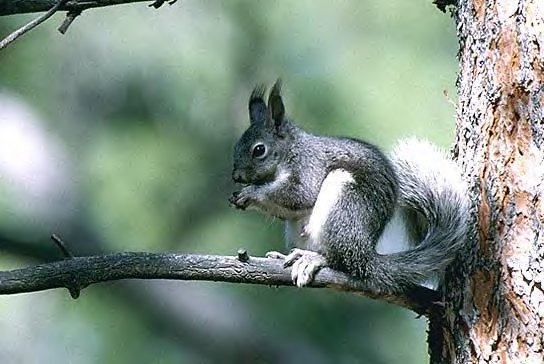Chipmunks, Squirrels, and Prairie Dogs
Description
A large tree squirrel. Dark, grizzled gray above with darker sides and reddish back; belly white. Tail above similar to back, but bordered with white and with whitish cast. Tail white below. Tasseled ears reddish on back, about 1 3/4" (44 mm) long, with tufts or "tassels" extending about 3/4" (18–20 mm) beyond ear tips. Tassels much reduced or even lacking in summer. In parts of Colorado, these squirrels are all black (melanistic). L 18 1/4–23" (463–584 mm); T 7 1/4–10 1/8" (185–255 mm); HF 2 5/8–3 1/8" (66–78 mm); Wt 24–32 oz (681–908 g).
Similar Species
Arizona Gray Squirrel lacks ear tufts.
Breeding
Litter of about 4 young born April–May after gestation of 46 days; in some years, more than 1 litter. Young are on their own by late June.
Sign
Nests, about 1' (300 mm) in diameter, placed high in trees, especially pine or juniper. Sign much the same as that of Eastern Gray Squirrel.
Habitat
Coniferous forests, including yellow or ponderosa pine, sometimes pinyon or juniper.
Range
Isolated mountainous areas in Arizona, New Mexico, se Utah and Colorado.
Discussion
Active throughout the winter, Abert’s Squirrel may remain in its nest in very cold weather, venturing out only to retrieve buried seeds, especially at tree bases where there is no snow. Seeds and the inner bark of the ponderosa pine, as well as terminal buds, staminate flowers, and pinyon nuts are its chief foods, but Abert’s Squirrel also eats mistletoe and other vegetable items. Nuts are buried in the ground, but no food is stored in the nest, which is built on a base of twigs placed in a tree crotch, about 20 to 40 feet (6 to 13 m) high, typically in a ponderosa pine. This squirrel uses its nest throughout the year, as a refuge by day and for sleeping at night. It either constructs a ball-like mass of twigs from pine or builds its nest within "witches’-brooms," growths of small pine twigs infected by dwarf mistletoe. The outside diameter of the nest measures from 1 to 3 feet (.3 to 1 m). The animal lines the inside of the 6-inch by 10-inch (157-254 mm) chamber with dry grass, leaves, shredded bark, or other soft, dry material. The nest is repaired as necessary. This species, like many other tree squirrels, engages in mating chases involving several males and one female. This activity may be witnessed in February or March, beginning in the morning and lasting all day. "Chase" is probably an inappropriate name for this behavior, however, as it is not really an active chase but rather the males following the female as she moves through the trees. The Kaibab Squirrel (S. a. kaibabensis), formerly considered a separate species, is now classified as a subspecies of Abert’s. It has dark underparts, an all-white tail, and is found only on the North Rim of the Grand Canyon. Abert’s squirrels are killed by hawks, hunters, and automobiles.


